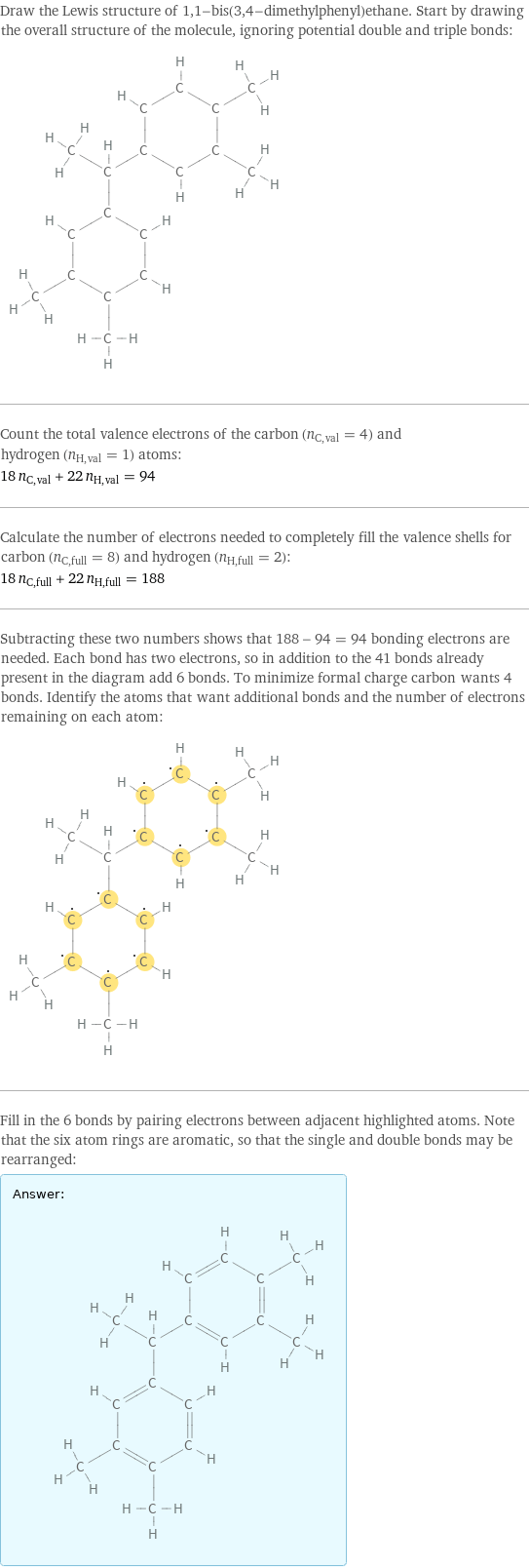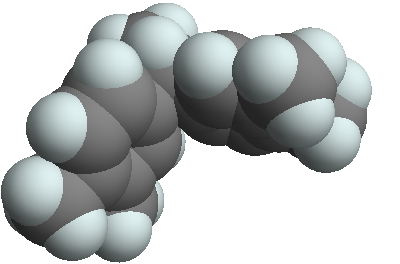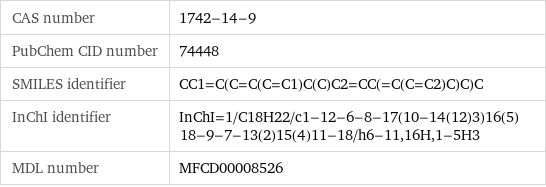Input interpretation

1, 1-bis(3, 4-dimethylphenyl)ethane
Chemical names and formulas
![formula | [(CH_3)_2C_6H_3]_2CHCH_3 Hill formula | C_18H_22 name | 1, 1-bis(3, 4-dimethylphenyl)ethane IUPAC name | 4-[1-(3, 4-dimethylphenyl)ethyl]-1, 2-dimethylbenzene alternate names | 1, 1-di-(o-xyly)ethane | 4-[1-(3, 4-dimethylphenyl)ethyl]-1, 2-dimethyl-benzene mass fractions | C (carbon) 90.7% | H (hydrogen) 9.3%](../image_source/79efbadf6eb5880b187e9e880852819f.png)
formula | [(CH_3)_2C_6H_3]_2CHCH_3 Hill formula | C_18H_22 name | 1, 1-bis(3, 4-dimethylphenyl)ethane IUPAC name | 4-[1-(3, 4-dimethylphenyl)ethyl]-1, 2-dimethylbenzene alternate names | 1, 1-di-(o-xyly)ethane | 4-[1-(3, 4-dimethylphenyl)ethyl]-1, 2-dimethyl-benzene mass fractions | C (carbon) 90.7% | H (hydrogen) 9.3%
Lewis structure

Draw the Lewis structure of 1, 1-bis(3, 4-dimethylphenyl)ethane. Start by drawing the overall structure of the molecule, ignoring potential double and triple bonds: Count the total valence electrons of the carbon (n_C, val = 4) and hydrogen (n_H, val = 1) atoms: 18 n_C, val + 22 n_H, val = 94 Calculate the number of electrons needed to completely fill the valence shells for carbon (n_C, full = 8) and hydrogen (n_H, full = 2): 18 n_C, full + 22 n_H, full = 188 Subtracting these two numbers shows that 188 - 94 = 94 bonding electrons are needed. Each bond has two electrons, so in addition to the 41 bonds already present in the diagram add 6 bonds. To minimize formal charge carbon wants 4 bonds. Identify the atoms that want additional bonds and the number of electrons remaining on each atom: Fill in the 6 bonds by pairing electrons between adjacent highlighted atoms. Note that the six atom rings are aromatic, so that the single and double bonds may be rearranged: Answer: | |
3D structure

3D structure
Basic properties

molar mass | 238.37 g/mol phase | liquid (at STP) boiling point | 173.5 °C (measured at 666.5 Pa) density | 0.982 g/cm^3
Units

Liquid properties (at STP)

density | 0.982 g/cm^3 refractive index | 1.564
Units

Chemical identifiers

CAS number | 1742-14-9 PubChem CID number | 74448 SMILES identifier | CC1=C(C=C(C=C1)C(C)C2=CC(=C(C=C2)C)C)C InChI identifier | InChI=1/C18H22/c1-12-6-8-17(10-14(12)3)16(5)18-9-7-13(2)15(4)11-18/h6-11, 16H, 1-5H3 MDL number | MFCD00008526
Safety properties

flash point | 110 °C